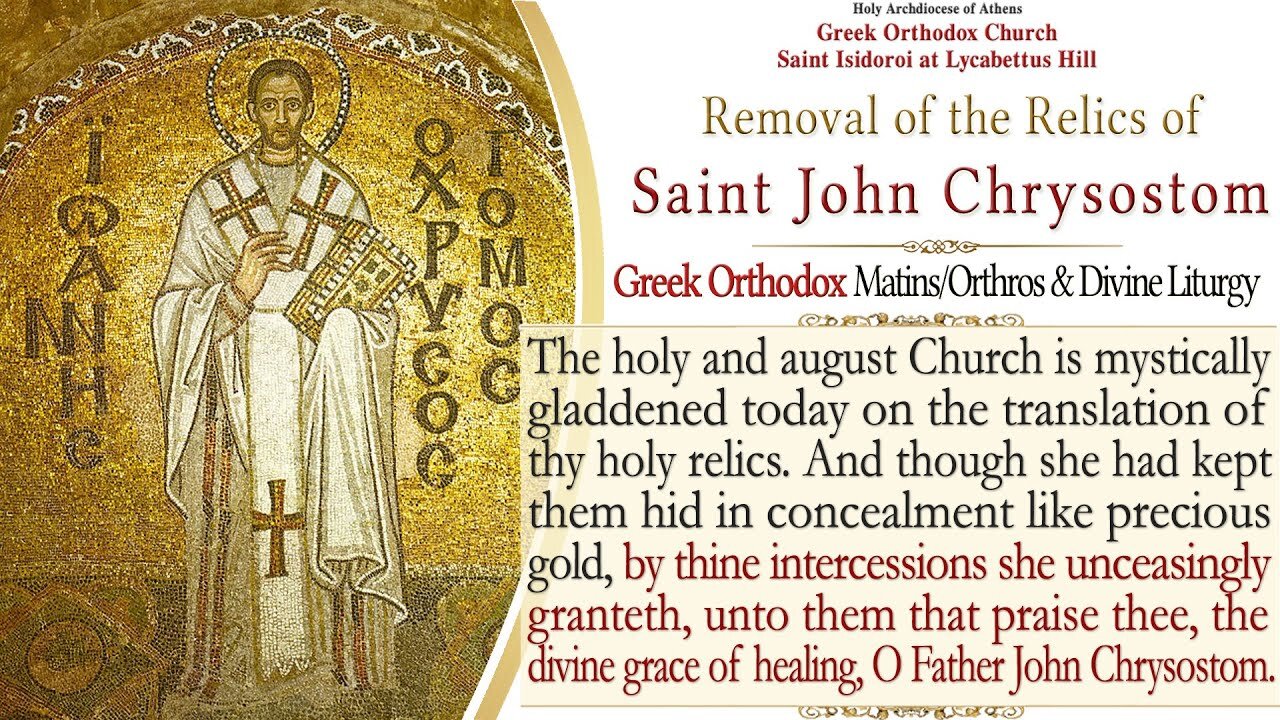Premium Only Content

Jan 27, 2022, Removal of the Relics of Saint John Chrysostom | Greek Orthodox Divine Liturgy
Saint John Chrysostom, the great ecumenical teacher and hierarch, died in the city of Comana in the year 407 on his way to a place of exile. He had been condemned by the intrigues of the empress Eudoxia because of his daring denunciation of the vices of those ruling over Constantinople. The transfer of his venerable relics was made in the year 438, thirty years after the death of the saint, during the reign of Eudoxia’s son emperor Theodosius II (408-450).
Saint John Chrysostom had the warm love and deep respect of the people, and grief over his untimely death lived on in the hearts of Christians. Saint John’s disciple, Saint Proclus, Patriarch of Constantinople (434-447), during services in the Church of Hagia Sophia, preached a sermon praising Saint John. He said, “O John, your life was filled with sorrow, but your death was glorious. Your grave is blessed and reward is great, by the grace and mercy of our Lord Jesus Christ O graced one, having conquered the bounds of time and place! Love has conquered space, unforgetting memory has annihilated the limits, and place does not hinder the miracles of the saint.”
Those who were present in church, deeply touched by the words of Saint Proclus, did not allow him even to finish his sermon. With one accord they began to entreat the Patriarch to intercede with the emperor, so that the relics of Saint John might be brought back to Constantinople.
The emperor, overwhelmed by Saint Proclus, gave his consent and gave the order to transfer the relics of Saint John. But those he sent were unable to lift the holy relics until the emperor realized that he had sent men to take the saint’s relics from Comana with an edict, instead of with a prayer. He wrote a letter to Saint John, humbly asking him to forgive his audacity, and to return to Constantinople. After the message was read at the grave of Saint John, they easily took up the relics, carried them onto a ship and arrived at Constantinople.
The coffin with the relics was placed in the Church of Holy Peace (Hagia Eirene). When Patriarch Proclus opened the coffin, the body of Saint John was found to be incorrupt. The emperor approached the coffin with tears, asking forgiveness for his mother, who had banished Saint John. All day and night people did not leave the coffin. In the morning the coffin was brought to the Church of the Holy Apostles. The people cried out, “Father, take up your throne.” Then Patriarch Proclus and the clergy standing by the relics saw Saint John open his mouth and say, “Peace be to all.” Many of the sick were healed at his tomb.The celebration of the transfer of the relics of Saint John Chrysostom was established in the ninth century.
Apolytikion of Relics of John Chrysostom
The grace of your words illuminated the universe like a shining beacon. It amassed treasures of munificence in the world. It demonstrated the greatness of humility, teaching us by your own words; therefore, O Father John Chrysostom, intercede to Christ the Logos for the salvation of our souls.
Kontakion of Relics of John Chrysostom
The holy and august Church is mystically gladdened today on the translation of thy holy relics. And though she had kept them hid in concealment like precious gold, by thine intercessions she unceasingly granteth, unto them that praise thee, the divine grace of healing, O Father John Chrysostom.
Watch live from the Greek Orthodox Church of Saint Isidoroi at Lycabettus Hill, the Matins/Orthros and the Divine Liturgy. The small church of Saint Isidoroi belongs to the Holy Archdiocese of Athens and is located on the west side of Lycabettus Hill in Athens, built inside the largest cave on the hill. According to tradition, this cave was a place of ascetic life of the Christians of the first centuries.
-
 2:38:55
2:38:55
Greek Orthodox Church St. Isidoroi, Athens, Greece
2 years agoNovember 11, 2022, Saint Menas of Egypt | Greek Orthodox Divine Liturgy
2621 -
 39:40
39:40
PMG
13 hours ago $2.28 earned"Paulo Figueiredo, Mehek Cooke, Ashley Hayek, Mark Mitchell- The Breanna Morello Show"
12.6K4 -
 3:37:41
3:37:41
Fresh and Fit
5 hours agoGirls React To Lily Philips Sleeping With 100 Guys
106K45 -
 27:00
27:00
Stephen Gardner
7 hours ago🔥McConnell ATTACKS Trump | HUGE Update on MILITARY DRONES mission!!
99.7K145 -
 8:10:03
8:10:03
Dr Disrespect
16 hours ago🔴LIVE - DR DISRESPECT - WARZONE - HUNTING SEASON
251K76 -
 1:32:28
1:32:28
Fresh and Fit
9 hours agoHow To Wholesale and Fix & Flip Real Estate!
64.5K10 -
 1:30:55
1:30:55
Flyover Conservatives
1 day agoDrones, Darkness, and Divine Intervention: Unpacking Prophecy and Reality - Dr. Troy Spurrill | FOC Show
39.2K2 -
 59:32
59:32
The StoneZONE with Roger Stone
8 hours agoHonoring Great American Patriots for Helping to Save our Country | The StoneZONE w/ Roger Stone
90.2K7 -
 1:09:50
1:09:50
Donald Trump Jr.
12 hours agoHow Sean Parnell Helped Deliver PA, Plus Why Pete Hegseth Must Be Confirmed | TRIGGERED Ep.199
212K93 -
 1:58:03
1:58:03
Tucker Carlson
10 hours agoJeffrey Sachs: The Inevitable War With Iran, and Biden’s Attempts to Sabotage Trump
209K348